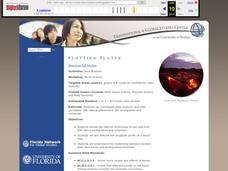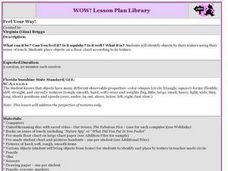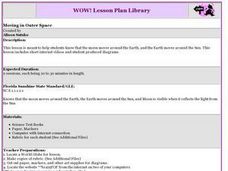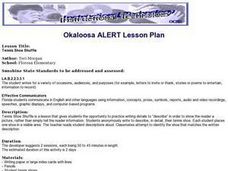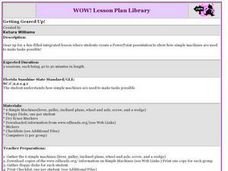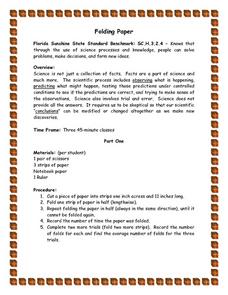Curated OER
Lighthouse Project
Middle schoolers research for Lighthouse information using the internet sites for research. They access how to identify captions that contain important information based on their research. Students design a page on a presentation program...
Curated OER
Multiplication Slideshow
Students create a slideshow of multiplication facts using Keynote. Students create slides with a multiplication fact and a picture representation for the multiplication facts from 2 through 5.
Curated OER
Egyptian Inspiration Web
Students conduct Internet research to discover information about scientific, technological, cultural and intellectual achievements in Egypt, along with Egyptian family life. Students create Inspiration webs of their findings.
Curated OER
Turtle Adaptations
Students identify structural adaptations of different types of turtles, and compare and contrast adaptations of painted turtles, sea turtles, and desert tortoises using a chart.
Curated OER
Bacteria Buddies
Tenth graders grow two different bacteria cultures. They count the colonies, and then use graphing calculators to predict the number of colonies that are going to appear. Students answer questions from their worksheet after completing...
Curated OER
Community Service Through Art: Empty Bowls
Fifth graders become more aware of the worldwide poverty issues. Through reading books, they can get a feeling for what the daily life of a person who lives in poverty is like. The research skills studied can be used in different subjects.
Curated OER
World's Deadly Diseases
Students gain knowledge on the cause/effect of five major diseases. They clearly locate where major diseases are located throughout the world. Students obtain statistical information through research of the population of the world...
Curated OER
Wetland Ecosystem Conservation
Learners read articles about wetland ecosystem conservation in Florida and other countries. They summarize information found in the articles. Students reflect on the information in the articles and write their feelings.
Curated OER
Plotting Plates
Students investigate plate tectonics and their correlation with natural phenomena like earthquakes and volcanoes. They use the internet to see real-time data about earthquakes and volcanoes. Students plot latitude and longitude points on...
Curated OER
What's Down There
Third graders gather and examine samples from the school outdoor environment. They compare/contrast their samples with those of other students. Students record the results of their observations.
Curated OER
Feel Your Way!
Young scholars investigate the sense of touch as they examine the texture of items in the classroom and from their homes. They watch a computer based video about the senses and draw items that are rough, smooth, soft, and hard.
Curated OER
Moving in Outer Space
Students participate in a lesson that demonstrates the concepts of rotation and revolution as they pertain to the Sun, the moon, and the Earth. They examine the relative sizes of each. They watch a computer based movie at a subscription...
Curated OER
Shoe Shuffle
Young scholars review the "word choice" writing trait, and recall how to use descriptive words to paint a picture. They write a description of one of their tennis shoes without sharing it with classmates. They place a shoe on display...
Curated OER
Getting Geared Up!
Pupils create their own Power Point presentation displaying clip art pictures of simple machines and telling how each machine makes tasks easier. They break into small groups and review information on simple machines from website and...
Curated OER
Geometric Gymnastics
Students explore the Math Dictionary for Kids site (see Weblinks). (They will discover the second set of terms is synonyms for the first set.) The teacher observes students' progress and provides feedback to students as they work at the...
Curated OER
Got Space?
Students explore our solar system of planets through research and activities. Using cooperative grouping and interaction, students gain an understanding of how the characteristics of the planets differ from one another.
Curated OER
Outer Space and Beyond
Students compare and contrast the size, characteristics, composition, and orbits of the planets in our Solar System. They view a PowerPoint presentation, and in small groups conduct Internet research on a selected planet. Each group...
Curated OER
The Giant Cell
After actively participating in a unit on cells, the students act out and become the organelles. They will act out and explain the functions of what each of the organelles do for the cell.
Curated OER
What Did He Say?
Students practice the use of Subjunctive I and II. They then analyze a text to find Indirect Discourse and practice writing sentences in Indirect discourse. For homework, students find an online article written this way in which they...
Curated OER
Where in My World Am I?
Students determine exactly where they are in the world by using a local map to write accurate directions to local eating establishments. They write precise directions from the school to their home which the teacher simulates driving to...
Curated OER
Earth and Seasons
Sixth graders comprehend that the path Earth takes as it revolves around the sun is called its orbit. They also comprehend that the axis is an imaginary line that passes through Earth's center and its North and South Poles. Students...
Curated OER
Making Sense of Density
Students identify the concepts of density, mass, and volume that define the property of a substance. They also determine that the properties of materials, such as, density and volume, can be compared and measured by using rulers,...
Curated OER
Energy Source
Sixth graders work in groups. They are given one type of energy to research. Students look through the different magazines or newspapers to identify pictures that show their type of energy. Students glue their pictures to the...
Curated OER
Folding Paper
Students use the scientific process and their knowledge to obeserve, predict, and test their predictions under controlled conditions to verify their predictions and then make sense of these predictions. They also graph, write...








